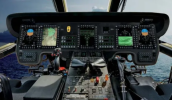Also from the Official Report…
“Issue 10: The use of other helicopters”
Event. Initial study of the Iranian situation and forces available quickly led to the belief that a rescue attempt would require heavy-lift, long-range helicopters. On 19 November 1979, the CJCS approved development of a plan using helicopters. The RH-53D was selected after an in-depth review of available helicopter resources and their inherent capabilities.
JTF Rationale. Primary criteria for selection included range, payload, and ability to be positioned rapidly; i.e., airliftable. Other major considerations were suitability of candidate helicopters to carrier operations and OPSEC. Primary candidates for the rescue mission were the CH-46, CH-47, CH-53, RH-53, and HH-53 military helicopters. All were C-5 airliftable, but range and payload considerations favored the -53 series, of the latter, the RH-53D provided the best combination of range, payload, and shipboard compatibility.
Alternative. Selection of the RH-53D for all the reasons was correct. However, it has been contended that specially configured HH-53 helicopters should have been favorably considered as primary replacements. On the other hand, these specially equipped helicopters were just coming off the production line, only a handful of pilots were proficient in flying them and operating their sophisticated systems, and they carry less payload than the RH-53D. In addition, reliability and maintainability of such a sophisticated system was doubtful at this early stage of its introduction.
Implications. On the positive side, specially equipped helicopters would have markedly improved ability. Considering that at the time there was no practical alternatives to launching the helicopter force from a carrier, the negative implications of the group’s alternative are the deciding factor. An HH-53 helicopter will not fit into a carrier elevator or below decks without removal of its rotor blades—a procedure not recommended for daily operations. The option of leaving helicopters on decks is virtually infeasible [unfeasible?] because of the corrosive atmosphere; difficulty of maintenance; impact on carrier operations; and, above all, OPSEC. Logistic support of a relatively new and exotic weapon system would be further complicated by the additional delays in shipboard resupply.
Evaluation. During the planning process, the RH-53D emerged as the only helicopter with the full combination of operational capabilities upon which a feasible rescue plan could be structured.
AND…
“Issue 13: Established helicopter unit”
Event. Selection of the RH-53D helicopter for the rescue mission naturally led to selection of an RH-53D squadron as the unit to perform the mission.
JTF Rationale. The JTF selected a minesweeping helicopter squadron as the most expedient solution when it became evident the RH-53D was the helicopter to use.
Alternative. The group would marry up the appropriate helicopters and their maintenance capability with an operational unit compatible with mission requirements. When it was clear that RH-53D helicopters were required, selection of a USMC assault squadron would have facilitated training and in constructing a credible OPSEC cover story. If necessary, highly qualified pilots from other Services could have augmented the Marine squadron to bolster its capability. The main point is that the squadron’s institutional structure would be preserved; e.g., training, tactics, and standardization. Personnel performing and experienced in these functions would greatly enhance the unit’s ability to smoothly transition into its new role. Perhaps one of the key squadron staff functions referenced above would have perceived the Blade Inspection Method (BIM)-associated abort experienced during training as a major potential cause of abort during the mission and pursued the facts as the review group did. (See Issue 17.) Armed with knowledge of the circumstances surrounding BIM failures, the pilots of Helicopter #6 could have reached a more informed decision on the risk associated with continuing.
Evaluation. It is believed the preservation of an established squadron’s inherent unit cohesion could have facilitated training, enhanced information flow, and increased aircrew knowledge, all of which could lead to a more integrated unit operation. It cannot be demonstrated nor is it suggested that these factors would have altered the outcome. However, they would have enhanced training and more likely increased the chance of success.

